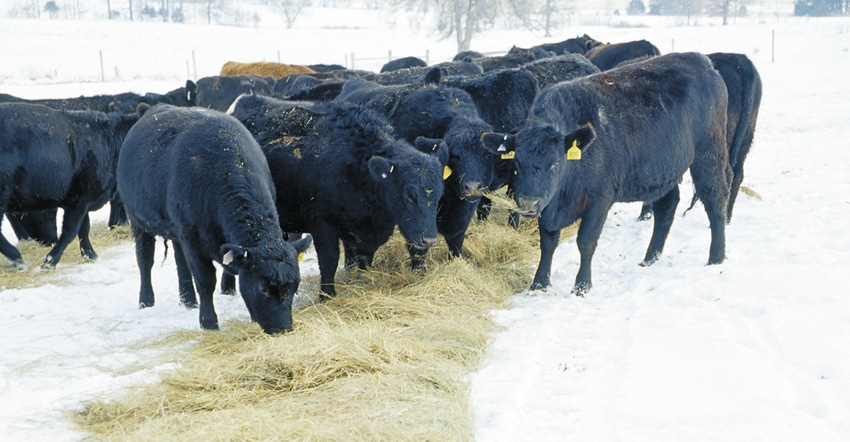October 3, 2019

By Erika Lyon
The last two years made it challenging for many producers to find good-quality feed for livestock, let alone a good quantity. Spoilage and high costs for subpar hay and grain can be discouraging. Health issues associated with poor-quality feed may range from starvation-like symptoms due to the feed lacking nutritional value, to death from contamination.
Producers may want to consider supplementing other types of feeds into winter rations to make up for loss in the nutritional value of traditional feeds, and to help offset costs. Feeds produced from byproducts can often provide an adequate amount of protein and energy, and they are often cheaper than conventional feeds — especially when conventional feeds are in short supply.
Many choices
Feedstuffs such as soybean hulls and corn gluten are often used to replace poor-quality hay during the winter months. Soybean hulls are the product of soybean oil and meal production, and may require heat treatment to prevent enzyme activity that results in nutrient loss. The fibrous content of soybean hulls can improve the digestibility of many forages for cattle in grazing systems.
Corn gluten comes from the wet milling process and is also a good source of digestible fiber. It contains crude protein, energy and minerals in abundance. The nutrient content of corn gluten does tend to vary among batches, so this byproduct may need to be tested before adding it to a ration. There may also be cost differences between wet and dry corn gluten feeds, since dry feeds are easier to transport over long distances. Conversely, wet corn gluten tends to have better nutritional value over the dry form.
Distillers grains left over from ethanol production are another example of a lower-cost byproduct feed. Since the starch is removed in distillers grains for fermentation, the remaining protein, fiber, minerals, and fat are more concentrated compared to what is found in conventional corn feed.
In dried distillers grain, protein typically ranges from 25 to 35% based on percent dry matter. The amount of fat within DDG solubles can reach up to 14%; although without the solubles component, this value drops to around 5%. DDG should not exceed 30% of dry matter intake in a diet.
It is a good idea to have distillers grain tested as the nutritional content will vary depending on the processes used by the ethanol plant and the form that the grain is in (dry, modified-dry, wet, modified-wet). Which form you decide to use will be based primarily on storage conditions, as well as nutritional goals. As with corn gluten, wet distillers grain is more expensive to transport over long distances.
If your farm is located fairly close to a brewery, you may have easy access to wet brewer’s grain. This grain includes barley, rice and/or corn, and they’re especially good feed supplements for ruminants. As with distillers grain, the malting process removes starch for fermentation, leaving behind concentrated amounts of protein, fiber and fat.
Wet brewer’s grain is a good source of digestible fiber, which makes it a valuable addition to some forage-based diets. Keep in mind that wet brewer’s grain will have a high percentage of moisture and can spoil in a matter of a few days, especially during the dog days of summer.
Therefore, storage should be a consideration when deciding whether or not to use these grains as part of a ration. Producers should also check the limits in the quantity per day that can be fed to cattle of different ages.
Evaluate pros and cons
These are just a few of the supplemental feeds available to livestock; there are many more options and numerous combinations to consider. The feed used will ultimately depend on each farm’s unique situation, as well as what is nearby and easy to get.
During years where the quality of conventional feeds is less than ideal, diversifying feeds can help to improve the nutritional value of a ration. When developing a ration, be sure to consider the costs of labor, as well as energy value of the feed, and evaluate the pros and cons of each feedstuff. Consider what is not in some of these feeds — will mineral supplementation be required?
Also, watch for excess nutrients — byproducts such as distillers grains can have concentrated amounts of phosphorus and sulfur. Regularly test the nutritional content of any feed to make sure it meets the needs of your herd.
Understand all of your feed options to get through shortages and “waste not” this winter.
Lyon is an Ohio State University Extension Educator in Jefferson and Harrison counties, and a member of the OSU Extension Beef Team. The Beef Team publishes the weekly Ohio BEEF Cattle letter which can be received via email or found at beef.osu.edu.
You May Also Like




